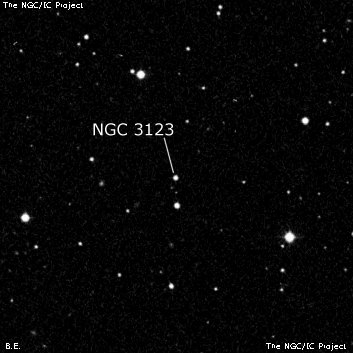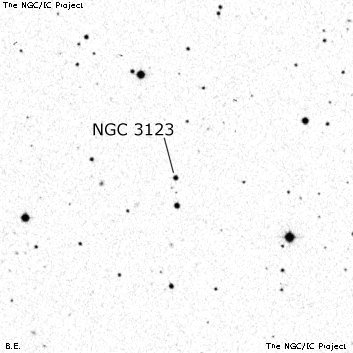NGC/IC Project Restoration Effort
(This is a very very beta version)
NGC3123


Basic Information
Location and Magnitude
Right Ascension: 10:18:11.9
Declination: +0:2:25
Constellation: SEX
Visual Magnitude: 11.0
Historic Information
Discoverer: Coolidge
Year of discovery: 1859
Discovery aperture: 15.0
Observational
Summary description: Neb, no description
Sub-type: *
Corwin's Notes
=====
NGC 3123. Here is my original note on this object:
[This] may be one of the stars, or the double star, that I've listed in the
table. There are no nebulae in the area that Sidney Coolidge could have
seen with the 15-inch refractor at Harvard.
His position is noted as having a range of 4 seconds of time in RA, and 2
arcmin in Dec. All of the objects I've noted as possibilities are more or
less within those ranges, though the star that I've noted with a single
question mark is closest. It has two faint companions to the south (one
looks like a galaxy) that may have added a bit of fuzziness to the image.
I should note, however, that many of the "nebulae" found during the Harvard
refractor's first decade are actually single stars, presumeably found on
nights of less than good seeing. This may be another of those.
However, Steve Gottlieb wrote in March 2015 that he has examined the Harvard
Zones where the object was first published. He has found that the only object
in Zone 117 which has a note even suggesting nebulosity is number 47 with the
remark "Has a perceptible disc?" The position of the object is given as
10 10 58.91, +00 44 39.3 for 1859.0; this precesses to 10 18 12.83,
+00 02 26.6 for J2000. Given the proper motion of -37.1 mas/yr in RA and -6.1
mas/yr in Dec, the position for J2000 (10 18 12.5, +00 02 26) corresponds well
enough that for UCAC4 451-050216 (10 18 11.89, +00 02 24.7).
Thus, the Harvard star is pinned down. But where does Bond (in AN 1453) find
the published position 09h 59m 48s +-4s, +00d 45' +-2' for 1859? The
declination is correct if the star is indeed number 117-47, but the RA is
wrong (there is nothing in the Harvard Zones at the position with that RA). I
am also curious about the errors that Bond assigns to the position -- the
typical differences in the overlap areas between measurements in the different
Harvard Zones is around 2-3 arcseconds, not the 2 arcminutes that Bond gives.
So, there are still some problems here. Still, I think that Steve has found
the correct object -- star 47 in Zone 117 -- so give that in the main table,
though with colons.



